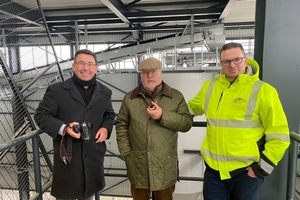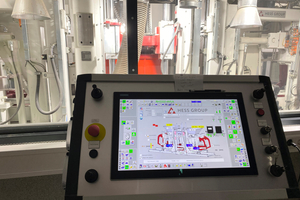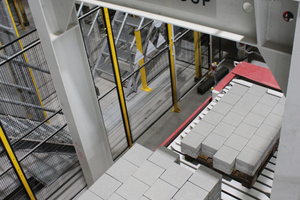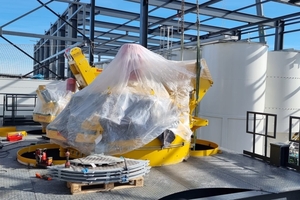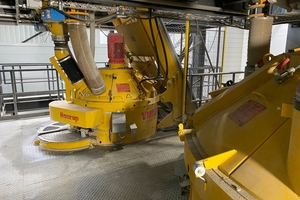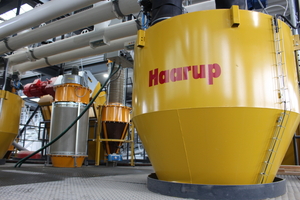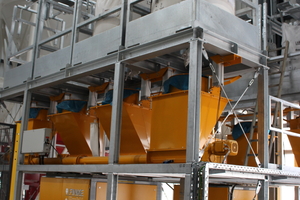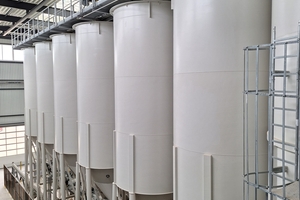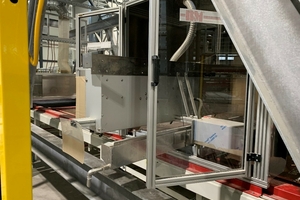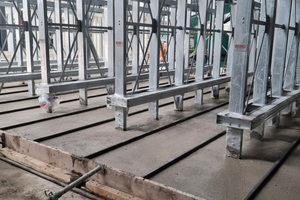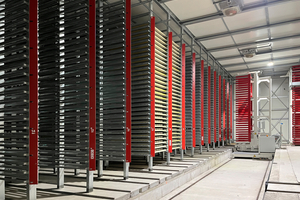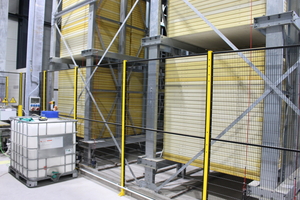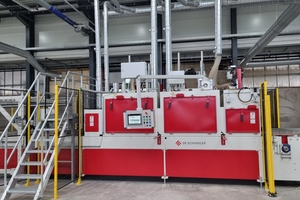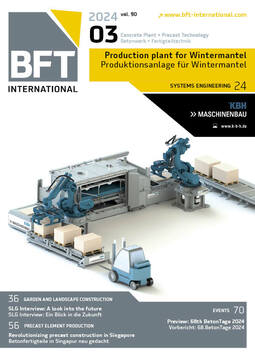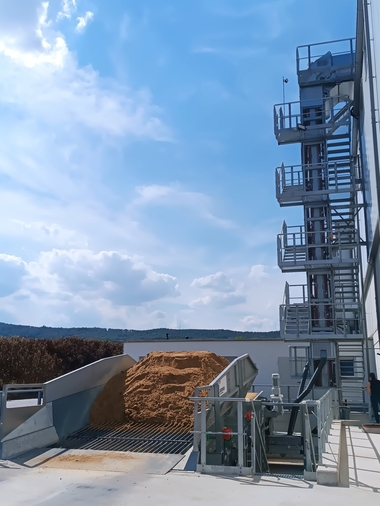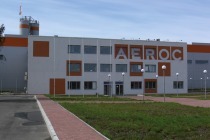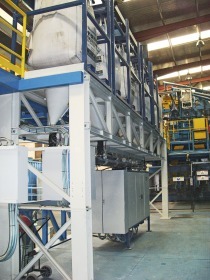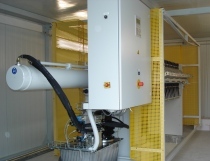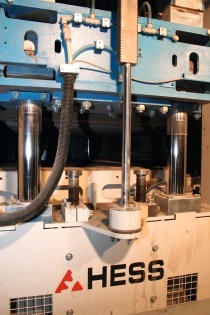New production plant for Wintermantel
concrete block factory started operation in Donaueschingen
Near the source of rive Danube, the concrete block factory of Wintermantel GmbH & Co. KG in Donaueschingen started production early in November 2023. Dr. Rolf Mohr (Management Board) and Plant Manager Rainer-Andreas Thome recently welcomed Editor-in-Chief Silvio Schade and Senior Sales Manager Jens Maurus from BFT International.
Meichle & Mohr GmbH based in Immenstaad and a total of 20 locations is part of the Baggergesellschaft Immenstaad Meichle & Mohr GmbH & Co KG with additional participations: Johann Wintermantel GmbH & Co. KG, Kalksteinwerk Schleith GmbH, Geisinger Kalksteinschotterwerk GmbH & Co. KG, KWV Jura Steinwerk GmbH & Co. KG, Kieswerk Schray GmbH & Co. KG, Kies- Beton Seegau AG, Adolf Birsner Spedition & Betonpumpenverleih GmbH & Co. KG, Schotter- & Kies-Union GmbH & Co. KG, Kiesgesellschaft Karsee GmbH & Co. KG and BBO Bauschuttaufbereitung GmbH & Co. KG.
After the foundation on March 19, 1924 – the roots date back to the 19th century – B. Meichle & Söhne & Gebrüder Mohr became Baggergesellschaft Immenstaad Meichle & Mohr OHG. Main business was the extraction of gravel from Lake Constance and cargo shipping on Lake Constance; later this was added by gravel pits on land and gravel plants as well as concrete plants from the 1960s onwards. Since the 1980s, gravel quarrying companies were acquired and participations and acquisitions of crushed stone works took place, respectively.
Today, the total holding comprises six gravel plants and gravel pits, four crushed stone works, six ready-mixed concrete plants, two concrete product factories as well as a participation in a forwarding company and a concrete pump rental company. This is complemented by a fleet of vehicles with approx. 100 trucks, soil excavation sites and the „Ultramarin“ sport harbor with full service.
Dr. Rolf Mohr reports: „We are a medium-sized supplier of construction raw materials with a wide product range and supply network. Securing of raw materials is getting ever more complicated, whether because of the acceptance among the population or escalating procedures for permission. Our fields of activity include everything relating to the supply of our customers involved in building construction and civil engineering as well as road construction using construction raw materials, concrete, mortar, RC products, concrete products, slot drains, fleet logistics and excavation works. At present, we are unfortunately in a downturn – as we are a 60 % dependent on construction –; the only exception is the sport boat harbor. Currently, we are erecting a washing plant for gravelly excavation material at a subsidiary.”
Comprehensive planning and construction process
Planning started in 2020/2021. In 2021, the decision was taken to build a new plant. In August 2021, the sales contract was concluded with Schindler company Hess Group. This replaces two old plants. Start of construction works were in February 2022 and the first production took place early November 2023.
Wintermantel GmbH & Co. KG had two plants at two locations: a Schlosser SV 400 from 1994 at the facility in Aldingen near Rottweil and a Schlosser SP 3000, 1995 model, at the Donaueschingen facility. The aim was to replace both out-dated machines with a new one at the location in Donaueschingen.
Specifications for the equipment manufacturer, above all, was the quality of the products, the availability of the plant, the annual quantity, reduction of rejects and to produce more environmentally friendly. Particularly challenging was the stabilization of the built subsoil and an integration of the old production halls with the new factory hall.
Until the total completion of the plant, the investment will amount to approx. € 25 million, according to the information provided by Wintermantel GmbH & Co. KG.
Plant manager Rainer Thome explains: „At times, 19 trades were involved in the installation process simultaneously. The concept of the entire plant was realized by the Hess Group. Martin Cochius, as project manager, has assumed the biggest part of coordination of the individual trades. Other persons and/or companies involved were Mr. Gabele and Mr. Eisele of Haller Industriebau and the structural engineer Wannemacher regarding the foundation. Mr. Sondergaard of Haarup hugely supported us in the field of mixing technology. Several companies submitted us a concept and quotation. Many reasons were in favor of the Hess Group: Quality, stability of the machine, modern, perfected technology, cycle times and automated mold change. Therefore, the overall concept of Hess worked best for us ultimately.“
The following presents the individual project partners and their scope of involvement:
Mixing plant by Haarup
One of the first project decisions was the selection of the Danish mixing plant manufacturer Haarup, who supplied a core concrete mixer, face concrete mixer and a mixer for slot drains each. In detail, these were two 3000-liter mixers and a 500-liter face concrete mixer as well as skip hoists and cement weighing units for these mixers. „Our mixers are distinguished by their very rugged construction and the reliability, which is why we grant eight years warranty on our mixers,“ explains Christian Sondergaard, Sales Manager at Haarup. „Together with the other manufacturers of machinery and suppliers, we take an active part in the design of the final factory layout through an exchange of ideas and drawings, while this collaboration run absolutely smooth and perfect, in our opinion.“
Block manufacturing system made by Hess
The Hess Group supplied and installed the RH 2000-4 MVA block machine in an ultra heavy-duty design and equipped with a high-performance control system for fast, precise and smooth motion sequences.
Thanks to the automatic quick-change system for molds, the currently inserted mold is released and rejected below the core mix unit; simultaneously the new mold is carried into the machine below the face mix unit and clamped. This saves time, is carried out conveniently by a single worker using a mobile panel, and reduces the risk of injury significantly.
Additional key components of the system include:
4 tamper head cylinders for optimum accuracy of the block height;
Colormix system for the face mix unit;
cubing with cover sheet dispenser, horizontal and vertical strapping as well as strip inserter;
separator unit for additional product control;
triple washout unit;
elevator/finger car/lowerator with 30 levels;
block remover;
2 x fully electric cubing system with servo motor (24.5m and 6.5m);
second dry side for an automated integration of the finishing line;
2 x lowerator;
1520mm pallet;
waterproofing unit with infrared drying for surface protection and
dry side prepared for sorting robot with lifting devices.
SR Schindler paving block refinement
SR Schindler supplied a finishing line featuring the following parameters:
Block and layer size: 800 x 800 up to 1,200 x 1,200 mm;
Smallest individual block: 100 x 200 mm, 200 in running direction;
100 x 100 mm for strapped layers only;
Product height: 40 up to 160 mm;
Max. layer weight: 750 kg;
Wooden pallets: Euro pallets of 1,200 x 800.
The SR Mega 6000-C-DUO bushhammering/aging line is designed as high-performance machine for bushhammering/aging of concrete blocks in different heights and a working width of 1,200 mm. It is a stand-alone through-feed machine consisting of a conveyor belt equipped with a heavy-duty, plastic coated ST fabric belt, rubberized driving drum and controllable feed drive, plus strengthened belt support in the zone of the bushhammering/aging tools.
The foil dispenser as auxiliary machine to the SR bushhammering/aging machine prevents surface damages caused on the concrete paving blocks during the aging process, so that only the edges are broken and the block surfaces retain their beauty as produced.
The SR Schindler shot-basting machine of type SR-1250 with cross-ripped rubber conveyor belt serves to provide the paving blocks and/or paving slabs with a blasted effect.
Furthermore, the scope of supply includes an electric and pneumatic switch and control unit as component of the shot-basting machine for central control of the machine via a Siemens S7-1500 programmable SPS with ProfiNet bus system. A KTP 700 touch panel in the control cabinet and SEW frequency inverters are equipped with ammeters for checking and adjusting the turbines.
An SR CA 1200-4 curling machine as linear unit in a heavy-duty tunnel design is intended for one-sided surface treatment of concrete blocks and concrete slabs of all kinds, in particular, of exposed concrete, ground/blasted and shotblasted surfaces.
The components of the circulation system include several layer pushers with transfer table and conveyor system as well as a layer stacking device with four-sided electromotive clamp. The main and secondary clamping is achieved electromechanically; including forced synchronization of the individual clamping jaws.
Concrete block curing system by Rotho
To design the equipment in accordance with state-of-the-art technology and also in compliance with all current environmental requirements, they once again opted for Rotho, who had already supplied the existing systems in Aldingen and Donaueschingen.
The new curing system consists of 14 rack bays with 30 levels and is designed for an overall capacity of 6.300 pallets. This time, the design version chosen was the Rotho climatic chamber, that is also known as „box-in-box solution“.
In addition to the proven Rotho clip-in technology, along with the standard head guidance, positioning wedges developed especially for this purpose were installed, centering any boards that may have shifted on the finger car.
Furthermore, the Rotho ProAir circulation system was installed for assuring and improving the product quality. In order to use this proven system as effective as possible, two preconditions are quite essential:
An insulation that is as thermal bridge-free as possible: for this purpose, the present rack system and the area of the transfer table in front were insulated additionally, which resulted in the above-mentioned Rotho „box-in-box solution“. This means, a completely clad and insulated curing area, featuring only two openings for storage and retrieval of the boards.
Sufficient air exchange to get the best possible consistent climate: for this purpose, the ProAir system extracts the moist warm air extensively beneath the roof insulation and blows it in again via an aluminum piping system installed underneath the lowest level. The hydration heat generated by the concrete blocks is uniformly distributed among the entire chamber, creating a climate in which the concrete products can harden quick and cost-effectively. Color deviations and efflorescence are reduced in the best possible way. An additional energy input is not necessary.
For the manufacture of high products, in every second rack level, a Rotho pallet buffer with a storage capacity of 3,240 pallets is integrated in the Hess circulation system. The pallet stacks are placed on special brackets allowing an enlarged feeding tolerance of the pallet stacks to the vertical supports. This guarantees maximum production security.
Performances of Assyx, Kraft Curing, OMS, Blum and Weber
The production pallets themselves were supplied by Assyx in April 2023 in the form of 6,500 DuroBoards in the dimensions of 1520 x 1100 x 55mm.
The finished products, passing a three-stage washing-out unit on these Assyx production pallets, are transferred via a V-belt conveyor onto a walking beam conveyor. On the way, the finished products are treated here (see text section on BM Anlagenbau) and are stored subsequently in the curing chamber of Rotho (see text section on Rotho) for drying. So that the climate created in the chamber does not escape, Kraft Curing has installed air curtains with a frame heating system on all three openings. Retrieval from the curing chamber takes place through two lines: one line for standard products, which are palletized and strapped by a horizontal and vertical strapping machine made by OMS. The labeling system of Blum prints and applies labels on the ready strapped block packs in an automated process.
The second line is used to carry the products to the finishing line made by Schindler. Here aging, shot-blasting, brushing, impregnation and infrared drying take place (please see ”SR Schindler paving block refinement”). This is followed by palletizing and strapping, again with the OMS make. The returned production pallets are cleaned by the Crust Cracker of Weber Bürstensysteme.
Remei BPB system partner since 2010
Remei BPB, a system partner of Wintermantel GmbH & Co. KG since 2010, provided consultation in respect of concrete technology, ranging from concrete formulations to the conduction of special concrete testing (CDF tests, testing of the weather resistance – QUV test) through to function tests for determining the water permeability of paving block systems, etc. In particular, they developed a special admixture for the customer, allowing them to set an optimum water-cement ratio in fresh concrete during concrete production.
The scope of delivery, furthermore, included the development of a concept for the production of concrete products with a „factory applied surface protection“, aiming at the possibility to deliver the concrete products manufactured with an effective protection against efflorescence.
The concrete formulations were modified in the first step so that porosity/water absorption of the hardened concrete is reduced to a minimum level. In the second step, a concrete impregnation is applied to the freshly made concrete products, counteracting the occurrence of lime efflorescence on the concrete surface. The product is applied in an automated spraying device on the wet side of the production line.
On the dry side of the production line, an automated spreading unit was installed for allowing spreading of the bio-based BPB Eco Spacer granulate. The Eco Spacer granules serve as spacers to prevent water logging between the individual block layers.
The contract is topped off with the development of a color concept for colored concrete products: Remei/BPB supplies a total of eight different concrete colors as powder pigments, enabling the production of 260 customized color shades in total.
Finke supplied universal powder metering system
The metering system for powder pigments supplied to Wintermantel is an 8-color double system, which is charged by big bags via a gantry crane.
The ‚universal system‘ allows batch-wise metering and pneumatic transfer of iron oxide pigments as well as titanium dioxide and chrome oxide. The metering system provides for a high metering accuracy and allows the addition of additive colors. It is a completely closed system for exact and low-dust processing of powder pigments.
Big bags are used for feeding the metering system; the bags are suspended in a special rack with discharge aid. An integrated gantry crane equipped with cross lifting beam is used for changing the big bags, without lifting the rack from the platform structure. Changing the big bags is done in an easy, fast and clean
manner.
The discharge nozzle of the big bag is connected to the system by means of a special docking station. The connecting piece is opened only after the big bag is docked, so as to ensure dust-free discharge of the pigment. This creates a closed, dust-free system and the pigment is discharged into the holding hopper by means of integrated discharge aids. The holding hopper is dimensioned so that the staff has sufficient time to change the big bag during the production process, without interrupting the flow of production. The current filling level of the big bag is continuously monitored and displayed by the control unit. Control of the color metering system is completely integrated in the mixing plant control system. The pigment is fed by means of metering screws of the weighing unit integrated in the system.
The weighing system is installed in a dust-proof housing. High metering speeds, with a high weighing accuracy simultaneously, can be achieved due to the use of frequency-controlled metering screws. The high weighing accuracy is realized through high-resolution weighing cells in combination with weighting electronics of high quality. Following the weighing process, the pigment batch is pneumatically supplied to the cyclone separators, which discharge the pigment into the mixer. This cyclone filter provides the advantage that no dust formation occurs during metering into the mixer. In addition, the cyclone separator also serves as storage for the next metering process.
Finke GmbH manufactures the metering system as a modular system, allowing them to realize short assembly times and reduced costs.
Coating Line by BM-Anlagenbau
BM-Anlagenbau und Dosiertechnik GmbH supplied the film-forming surface protection. The coating line is a component part of the already existing process technology at the customer. The system of BM-Anlagenbau itself provides a high power density with a heat capacity of 84 kW for the heat energy required. A spraying device is installed on the wet side, another one on dry side. The system processes layer widths of up to 1,250 mm. The infrared heating system is ventilated centrally; this is an additional protection against contamination of the glass bulb illuminants. Moreover, the efficiency of the cooling capacity is considerably higher than for conventional ventilation and/or cooling. The products are coated with a film-forming agent on the finishing line made by SR Schindler. After the drying process, the pre-coated products are again coated on the dry side and are dried by means of the infrared heating system. Individual configurations of coating material and quantity are possible here. The system allows motorized adjustment to the layer sizes fully automatically; both the layer width and the product height can be adjusted in a recipe-controlled process. After coating, the products are transferred to the packaging process.
Maurice-André Ortsiefer, Operations Manager at BM-Anlagenbau, explains: “The spraying device is operating with a low-pressure system. In this regard, the BM-Anlagenbau works with the well-known pulse width modulation, thus allowing individual adjustment to the applied quantity as requested. In general, an adaptation to the width size is possible any time; likewise an adaptation to different conveying speeds. Adhesions outside of the application system can be removed with the aid of the HDC system in ongoing process; HDC stands for hydro dynamic clean. This system operates with a mixture of water and compressed air. The nozzle is dried with compressed air immediately after the cleaning process. The circulation system that is free of dead space ensures maintenance processes with fast operational readiness after a time off work shift or after maintenance works carried out on the system. The spraying line is equipped with a pull-out system, allowing fast and efficient maintenance of the spraying system providing the conditions of an ergonomic working environment.”
The infrared heating unit is operating with quartz tungsten heaters, achieving extremely high energy densities. The central ventilation system reliably generates the air flow required for the drying process, so that humidity occurring in the drying environment can be removed from the process area effectively. Due to a pulse width modulation used for power control, the heating units can be adjusted individually to the process, thus responding to diverse application requirements in respect of the application quantity, type of coating material as well as the corresponding product surface. The power control is infinitely variable from 0 up to 100% power.
Kurz Silosysteme and Techmatik
Kurz Silosysteme supplied and assembled 15 silos with diameters between 3,500 mm and 5,000 mm used for aggregates as well as three silos with a diameter of 2,900 mm for binders. In this regard, Oliver Passek, authorized representative at Wilhelm Kurz & Söhne GmbH & Co. KG, states: „The optimum storage capacities were determined together with the plant operator in extensive preliminary discussions. It is in particular reflected by the diameters selected for the silos.“
The contract for the supply of 39 complete molds for the new HESS machine at Wintermantel was awarded to SD Solutions/Techmatik. General Manager Frank Schunack explains: „Till this day, it has been the biggest individual contract in the cooperation between SD Solutions GbR and Techmatik. This was a great sign of confidence for us, because Wintermantel had no experience at all with molds of Techmatik so far. Why did they choose us? I think that we have scored in Germany with our service and the very good references in the meantime, as well as because of the very good business relationship that has been existing between me and Mr. Superson and Mr. Thome for several years now. The topic of delivery time and, above all, delivery reliability have been decisive aspects as well. The paving block molds were all supplied in the Monolith/Dynahard design, which has meanwhile established itself on the German market completely.“
Other project partners
The initial planning was carried out by the regional architect Gert Thielsch. He also prepared and submitted all documents for permission.
Following the subsoil stabilization, concrete works and foundation works were executed by the Frank Matthes company.
The production hall and the silo hall were constructed by Haller Industriebau, as well as the mixer platform for the three above-mentioned Haarup mixers. The actual silos were supplied and installed by Kurz Silosysteme.
The so-called Flat Feeder and double belt conveyors as well as mobile and reversing conveyors above the silo plant, for feeding the silos with concrete aggregates, were supplied and installed by VHV.
The noise protection cabin for the plant operators, the plant manager‘s office and the sound insulation cabin for the aging line made by Ergo System were procured and assembled through the Polish company TTP. All stairs and passages as well as security fences, dust collection systems, silo covers and the assembly personnel were ordered via TTP as well.
SST Elektrotechnik has executed all electric works. The heat supply in the factory hall is controlled with the aid of a hybrid system supplied by the Etapart company.
In addition, several authorized experts, engineering offices and structural engineers were involved in the project.
Future outlook
„Our objective is to begin with the two-shift operation as soon as possible, so as to work to full capacity. This yet gives rise to many more activities.“ concluded Rainer Thome. „A new gravel plant was built at the Reiselfingen gravel pit, 20 km away from Donaueschingen, for example; it will start operations these days. The entire aggregates will be delivered to Donaueschingen from this plant by overnight transport. The plant is in the midst of commissioning. Production runs only in single-shift operation at present. As said before, we intend to run the plant in two-shift operation on five days a week, with a capacity of 1 million m². The PV system has to be put into operation yet; the storage yard around the new building is just about to be opened. As soon as the new plant has reached full capacity, the Aldingen plant will be shut down. Last but not least, the warehouses situated in Aldingen will be disassembled and reassembled in Donaueschingen.“
CONTACT
Johann Wintermantel GmbH & Co. KG
Pfohrerner Str. 52
78166 Donaueschingen/Germany
+49 771 83224-75

